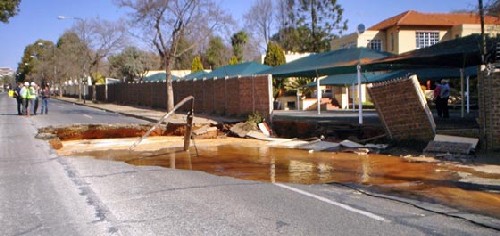I’ve spent most of the last three days camped in front of a scanning electron microscope, looking at lots of evil iron sulphides. And when I say ‘most’, I really do mean ‘most’. The problem when you want access to shiny bits of analytical kit is that there’s lots of other people jostling for access with you. Thus, when you finally get a precious day or two of machine time, things like food and sleep tend to slip a little down the priority queue, because who knows how vital that wasted hour could be, and how long you’ll have to wait to get another one?
The reason I wanted to try out the instrument here is that it’s tooled up with some fancy automated software which can scan entire slides on its own, picking out particular mineral phases, and recording their shape and location. This means that rather than my time being eaten up by manually moving the stage around, looking for things of interest, I could just quickly zip between different iron sulphide aggregates, looking at the different growth patterns of pyrite and greigite, and how they varied between samples with different magnetic properties. Even though I have studied these slides before, I’ve been getting pretty excited about how much more, and how much cool new stuff, you get to see with this instrument’s help compared to my previous sessions. But despite the automation, and despite the scientific potential of all this new data, the actual process of reviewing the data is still pretty monotonous: select and move to an aggregate the machine has found, note down the growth patterns, analyse some of the phases to check what is what, take a photo, then rinse and repeat. Yesterday, after spending a fair proportion of the hours between Saturday morning and Sunday evening doing this, 15 hours of this on Saturday, and an early start yesterday, my brain was starting to shut down in protest. It was fortunate that I still had a bit more time this morning to finish reviewing all of my slides.
I’ve always been quite good at focussing on an important task for stupidly long lengths of time (in between bouts of intense procrastination), so it was quite disturbing to find myself running out of mental steam so easily. When I think back my undergrad days, and even during my PhD, the sort of weekend I’ve just had was not an uncommon occurrence. In my defence, this work is filed under ‘speculative side-project’, so there wasn’t the spur of a looming deadline to keep me focused once I started to flag yesterday evening. And the extreme monotony of this sort of work makes it difficult for your mind not to wander eventually; I’ve given up SEM sessions in the past for just the same reason. Perhaps, though, I’m just getting old, and the days when I could shrug off an all-nighter are past me – and my all-time record of four nights without sleep (which included playing a rugby match on day three) will forever remain unbeaten.




Nice plan for content warnings on Mastodon and the Fediverse. Now you need a Mastodon/Fediverse button on this blog.